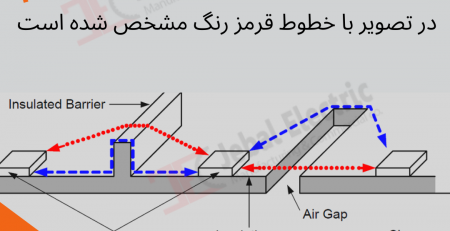Breakdown in solids / شکست الکتریکی در جامدات
- Breakdown in solids
Solid insulation forms an integral part of high voltage structures. The solid materials provide the mechanical support for conducting parts and at the same time insulate the conductors from one another. Frequently practical insulation structures consist of combinations of solids with liquid and/or gaseous media.
Therefore, the knowledge of failure mechanisms of solid dielectrics under electric stress is of great importance.
- Intrinsic breakdown
If the material under test is pure and homogeneous, the temperature and environmental conditions are carefully controlled, and the sample is so stressed that there are no external discharges. With undervoltages applied for a short time the electric strength increases up to an upper limit which is called the intrinsic electric strength. The intrinsic strength is a property of the material and temperature only. intrinsic strength is generally assumed to be reached when electrons in the insulator gain sufficient energy from the applied field to cross the forbidden energy gap from the valence to the conduction band.
2. Streamer breakdown
Under certain controlled conditions in strictly uniform fields with the electrodes embedded in the specimen, breakdown may be accomplished after the passage of a single avalanche. An electron entering the conduction band of the dielectric at the cathode will drift towards the anode under the influence of the field gaining energy between collisions and losing it on collisions. On occasions the free path may be long enough for the energy gain to exceed the lattice ionization energy and an additional electron is produced on collision.
3. Electromechanical breakdown
Substances which can deform appreciably without fracture may collapse when the electrostatic compression forces on the test specimen exceed its mechanical compressive strength.
4 Thermal breakdown
5 Erosion breakdown
Practical insulation systems often contain cavities or voids within the dielectric material or on boundaries between the solid and the electrodes. These cavities are usually filled with a medium (gas or liquid) of lower breakdown strength than the solid. Moreover, the permittivity of the filling medium is frequently lower than that of the solid insulation, which causes the field intensity in the cavity to be higher than in the dielectric. Accordingly, under normal working stress of the insulation system the voltage across the cavity may exceed the breakdown value and may initiate breakdown in the void.
6 Tracking
- شکست الکتریکی در عایق ها*
- شکست در جامدات
جامدات عایق به عنوان نگهدارنده مکانیکی بخش های هادی جریان عمل میکنند و به طور همزمان هادی ها را نسبت به یکدیگر عایق میکنند. ساختار اغلب عایقهای کاربردی ترکیبی از جامدات با مایعات یا گاز است. بنابراین، دانش مکانیکی شکست دی الکتریکهای جامد تحت ضربه الکتریکی اهمیت زیادی دارد. شکست الکتریکی عموما در نتیجه افزایش ولتاژ و عبور آن از آستانه تحمل عایق رخ میدهد که موجب آزاد شدن جریان ناگهانی غالبا نامطلوب میشود.
شکست ذاتی
اگر مواد تحت آزمایش خالص و همگن باشند، درجه حرارت وشرایط محیطی با دقت کنترل شود و هیچ تخلیه خارجی وجود نداشته با اعمال ولتاژپایین برای زمانی کوتاه ، استحکام الکتریکی تا حد بالاتری افزایش می یابد که به آن استحکام الکتریکی ذاتی گفته می شود .استحکام ذاتی صرفا خصوصیتی از ماده و دما است . به طور کلی فرض می شود شکاف ذاتی زمانی اتفاق میافتد که الکترون ها در عایق انرژی کافی برای عبور از شکاف انرژی بین لایه ظرفیت و لایه هدایت را به دست آورند .

*[High Voltage Engineering,second edition ; kuffel,w.s.zaengl]
شکست الکتریکی استریمر
تحت شرایط کنترل شده خاص ، با قرار دادن دو الکترود در دو طرفت نمونه عایق تحت آزمایش ، با افزایش ولتاژ و عبور اصطلاحا یک بهمن الکترونی از کاتد به آند ، شکست استریمر اتفاق می افتد . گاه حرکت الکترون ها در این مسیر آزاد باعث میشود انرژی حاصل از آن افزایش یافته و بهمن الکترونی دیگری ایجاد می شود.
شکست الکترومکانیکی
موادی که بدون شکستن ، تغییر شکل میدهند،ممکن است در صورت افزایش نیروهای الکتروستاتیک فشاری از حد مجاز، دچار فروریختگی مکانیکی شوند .
شکست دمایی
شاخه زنی
شکست فرسایشی








دیدگاهتان را بنویسید